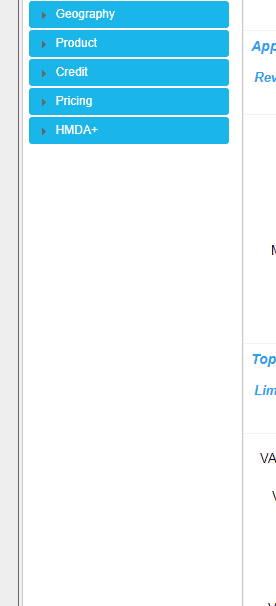Since the Final HMDA Rule was released in 2015, the banking sector has undergone dramatic changes. In this article, you’ll learn how the extended HMDA data, sometimes referred to as HMDA Plus data, impacts Fair Lending monitoring and analysis.
Navigating this rapidly evolving compliance landscape is a challenge; this post will also show you a few ways that best practice institutions are responding.
You might expect that 48+ new HMDA data fields would have a big impact on Fair Lending analysis. If so, you’d be right.
The changes to the Home Mortgage Disclosure Act’s data collection and submission requirements over the last few years have sent shockwaves through the banking compliance industry. Financial institutions have struggled, and mostly succeeded, in responding to the new requirements.
Of course, it is changing the way financial institutions collect HMDA data and submit the HMDA LAR to the government. If you have to comply with HMDA, you know this already.
In addition, this new data is definitely having an impact on how banks, credit unions, and mortgage companies are analyzing their HMDA LAR for Fair Lending compliance risk.
In this post, you’ll learn how the extended HMDA data is changing Fair Lending compliance analysis, and what you can do about it.
Let’s jump in with a few ways that your analysis is likely to change.
In a nutshell, this new HMDA data provides 1. clearer analysis, and 2. deeper insights. This is particularly evident when trying to identify the causes of potential disparities, and when researching your market and competitors.
Less HMDA “File Diving”
Let’s start with the first scenario: you’re analyzing your HMDA data, and you’ve identified a disparity. When this happens, you’re probably used to digging through loan files, or “file diving,” to try to understand the disparity.
In the past, file diving has been an important part of the HMDA analysis, monitoring, and risk management process. With the expanded HMDA data, you can kiss that (mostly) goodbye.

The breadth of the new data requirements means no more file diving! Or at least, lots less. This is because the data has many of the fields we need to investigate the most common Fair Lending risks. Here’s an example:
In our Fair Lending analysis reviews, we might sometimes identify a denial disparity that appears to be discriminatory. However, such disparities can often be explained by factors like credit score or debt-to-income ratio (DTI). Since these data points are now included in the HMDA data, we can see common factors that may have contributed to the denial immediately, without having to go into the individual files.
Other factors, like the channel through which the application was received, are also illuminated by the new data requirements.
If you do need to compare files, know that some software solutions (like Ntransmittal) do include built-in comparative file review. You can see how the comparative file review looks in the image below:

Deeper Competitive Analysis
As mentioned earlier, another way that the HMDA Plus data is changing Fair Lending analysis is by providing deeper insights into the market and competitors.
Lately, it’s been a hotly discussed topic. Can financial institutions really gain meaningful competitive insights from the expanded HMDA LAR?
While this is still evolving, it's true that the additional HMDA data does provide financial institutions the opportunity to clearly and accurately benchmark themselves against peers and competitors. It's almost like being able to spy on your competition.
You can use the public HMDA data and your own internal HMDA data to conduct strategic planning.
For example, you can learn which groups are being best served in your community, or understand what percentage of the market share other financial institutions have. You can identify your competitors in a particular market area, flag new competitors year-over-year.
You can even evaluate your competitors’ strengths and weaknesses, and see how your institution compares, by looking at origination rates, denial and fallout rates, and more.

This process of understanding your peer institutions and the benchmarks can help you understand how your institution is doing well - and where you can improve.
Even More Details on How the HMDA Plus Data is Changing Fair Lending Analytics
Since the Final HMDA Rule was released, we’ve been working on improving Ncontracts to make Fair Lending analysis even more helpful.
Here are a few of the product enhancements you will see:

- Credit Analysis Bar
- The Credit Analysis bar filters the data to only show HMDA applications or originations within a certain credit score, DTI or LTV range. This lets you review key underwriting factors, which also helps to cut down on the number of files to look at.
And those are just a handful of the improvements launched in the last few years to make HMDA and Fair Lending analysis easier for compliance professionals like you. Here’s what one customer had to say:
"HMDA Plus analysis is a key annual scheduled review that our top executives and I have conducted for the last 5 years. Year over year, we can view resolved issues and address any new areas of potential risk.
As a lender, you want to ensure that your benchmarks in pricing, adverse loans, steering and underserved areas are in line with your peers statistically. With the changing regulatory environment in recent years, it is a best practice to be “in the know” and discuss planning as needed, rather than hurriedly responding to a regulator.
I can personally attest that if any client has a need to drill down, Ncontracts will go above and beyond to address any and all concerns. We truly embrace our partnership."
- Lisa Fox, Branch and Loan Servicing Manager, RWM Home Loans
We love working with you, Lisa, and are so happy to be your partner! Thank you for the kind words, and your trust.
If you'd like to learn more, you can get a quick, risk-free demo today. The demo is customized, meaning that we'll only focus on the areas that will be most relevant for you and your financial institution. No boring, one-size-fits-all demo presentations here! Sign up today to learn how to improve your HMDA compliance.